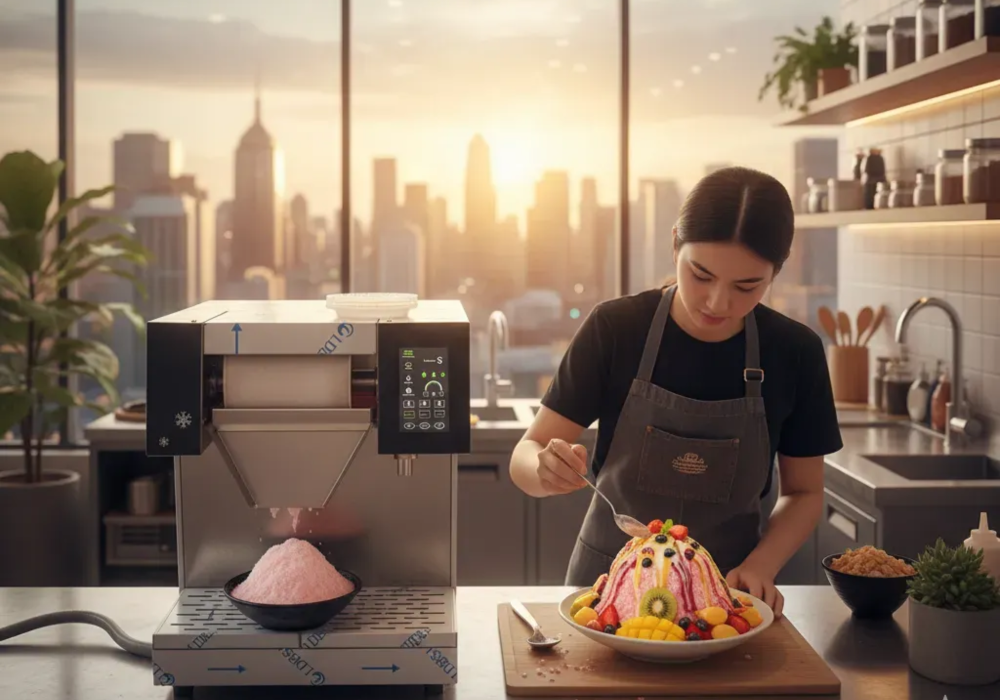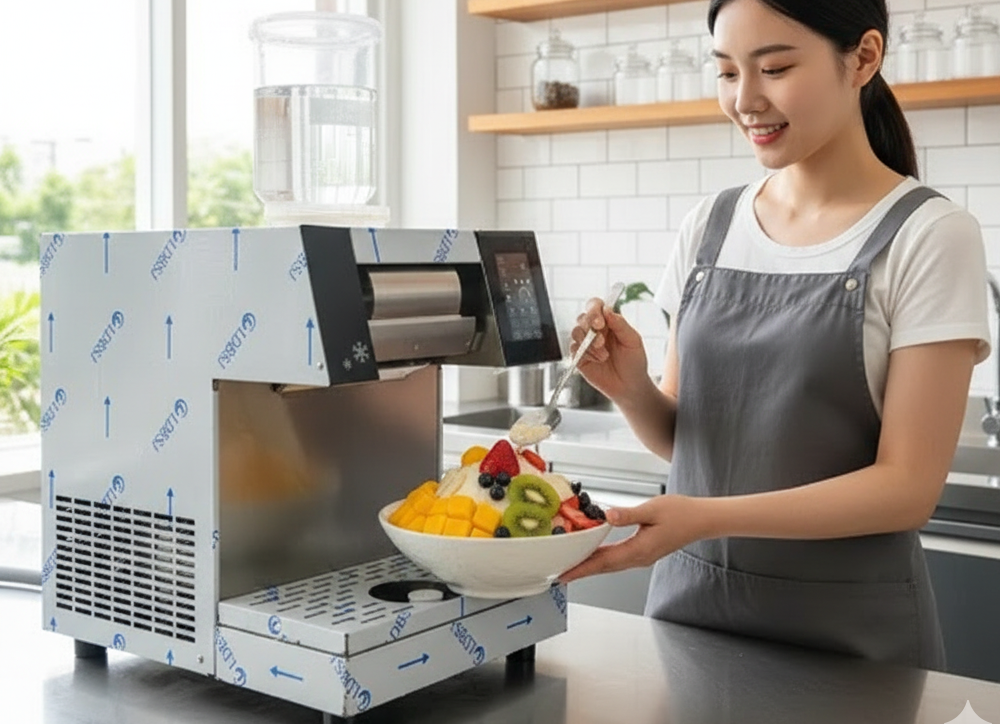
Emerging Global Trends in Dessert Equipment: What Ice-Shops and Restaurants Need to Know in 2025–2030
Emerging Global Trends in Dessert Equipment: What Ice-Shops and Restaurants Need to Know in 2025–2030
In recent years, the frozen dessert sector has been evolving rapidly—not just in flavors or consumer tastes, but in the underlying equipment, production models, and supply chains. For ice-creams, gelatos, snow ice, and fried-ice, technology and market forces are reshaping what machines are bought, how they are used, and what consumers expect. For restaurant and ice-shop owners planning investments, understanding these macro trends is essential to stay competitive.
Here are several key trends and their implications for equipment selection, business strategy, and future opportunities.
1. Market Growth & Regional Demand Shifts
Rising Global Scale & Compound Growth
- The global market for ice machines is expected to expand at a CAGR of roughly 5-7% from 2024 through 2030. One survey projects that the total market will grow from around USD $10-20 billion baseline to significantly higher, driven by expanding out-of-home dessert consumption and premiumization. (Data drawn from multiple non-English market reports.)
- Within sectors, machines for snow/flake ice are showing especially strong growth, especially smaller-capacity machines (<100-200 kg/24h), which are suited for boutique dessert shops.
Hot Regions: Asia-Pacific, Europe, and Seasonal Markets
- Asia-Pacific is increasingly dominant in both demand and supply. Countries such as China, Japan, and Korea are major consumers of snow/flake ice machines and gelato-style equipment.
- Europe continues to maintain strong demand, especially in countries with entrenched gelato culture (Italy, Spain, France). For example, gelato consumption in Spain has been increasing by ~3-5% annually, even under uncertain economic conditions.
- Seasonal tourism zones (coastal towns, summer resorts) in Europe and parts of Latin America also drive spikes in demand for mobile or smaller machines (kiosks, trucks).
2. Feature & Technology Trends in Equipment
Efficiency, Automation, and Full-Automatic Machines
- Demand for fully automatic snow/flake ice machines is rising: machines that can minimize operator intervention, offer consistent output, and maintain hygienic standards. These appeal especially in high throughput operations or franchise chains.
- Energy efficiency is a major concern. Models with better refrigeration systems, optimized compressor design, low-GWP (Global Warming Potential) refrigerants, improved insulation, and lower standby energy use are gaining favor.
Modularity, Scale Flexibility, and Smaller Footprint
- Smaller units that can scale capacity are popular for boutique dessert shops, pop-ups, food trucks, and otherwise tight interior space.
- Also, machines with modular parts or options (e.g. exchangeable freezing plates, interchangeable flavor / ingredient modules) are favorably viewed.
Hygiene, Food-Safety, and Design Aesthetics
- As consumers increasingly expect transparency and cleanliness, equipment with food-grade materials (stainless steel, easy-clean surfaces), built-in UV sterilization or self-cleaning functions, closed-loop water systems, etc., are in demand.
- Design has aesthetic_value too: sleek machines visible to customers (open kitchens, dessert bars) are being used as part of brand identity.
3. Product Categories Seeing Momentum
Snow / Flake Ice Machines
These machines are growing fastest in many Asian markets. Key drivers:
- Trend toward soft, chewable texture: snow ice offers a different mouthfeel.
- Lower entry cost and lower maintenance (for small-capacity models).
- Use beyond dessert: snow ice machines are also being used for cold drinks, tea shops, bubble tea with “snow” topping, etc.
Gelato & Artisanal Ice Cream Machines
- Growth in gelato consumption in Europe is stable: +3-5% in many markets, even under broader economic uncertainty. (Consumers tend to treat gelato as an accessible luxury.)
- Artisanal batch freezers (small to mid scale) are in demand, for shops that want full control of texture, overrun, and flavor.
- There is also increasing interest outside Europe: Asia and North America opening more gelaterias focusing on “craft” identity and high‐quality ingredients.
Fried-Ice (Teppan Ice / Rolled Ice / Stir-Ice) Machines
- The fried-ice / rolled-ice equipment market is smaller now, but expected to grow at CAGR ~5-6% through the next decade. These machines are often used in entertainment or novelty dessert shops.
- Their attractiveness lies in performance as spectacle: consumers enjoy watching the cooking/frying/rolling process, adding value beyond just flavor.
4. Business & Operational Trends
Multi-Use Equipment & Hybrid Models
- Shops are increasingly looking for equipment that can serve dual (or multiple) roles: e.g. a gelato-batch freezer that can also be used for ice cream, or snow ice machines that also work for cold drink display. This helps maximize return on investment.
Leasing / Financing vs. Ownership
- Given upfront cost of high‐end machines (gelato batch freezers, fully automatic snow ice machines, etc.), many restaurants are shifting toward leasing or financing models. This reduces capital risk, allows upgrades.
Supply Chain, Localization, After-Sales
- Proximity of manufacturing, spare parts, timely maintenance are becoming differentiators. Buyers prefer brands that have local service networks or can respond quickly.
- Also, quality control is now elevated—not only reliability, but compliance with international food safety standards (e.g. CE, NSF, HACCP) matters for exporting or high-end branding.
5. Challenges & Risk Factors
- Energy Cost & Environmental Regulations: Refrigeration is inherently energy-intensive. Regions tightening rules on refrigerants (toward low-GWP, non-ozone depleting options) will force redesigns or upgrades.
- Material Costs & Supply Chain Disruption: Stainless steel, compressors, electronic components may see volatile pricing, especially under global logistic constraints.
- Labor / Skill Gap: Especially for gelato shops or shops offering live dessert preparation (e.g. fried-ice), there is often a shortage of skilled staff (artisan ice makers, front-of-house).
- Consumer Preferences Shift: Flavor trends, dietary concerns (e.g. vegan, low sugar), sustainability concerns (packaging, energy use) mean machines must support flexibility (e.g. mixing, alternative ingredients) and messaging.
6. Strategic Implications for Restaurant / Ice-Shop Owners
Given these trends, what should you consider when planning equipment investment, menu builds, and business model?
| Decision Area | What to Prioritize |
|---|---|
| Machine Specification | Choose based on typical peak output (not just average); consider future capacity expansion. Prioritize energy efficiency / low operating cost. Ensure hygiene and food-safe materials. |
| Flexibility | Machines that allow menu innovation (mixing, layering, toppings) will stand out. Also modularity for flavor, texture control. |
| Brand Positioning & Consumer Experience | If the equipment is visible, its aesthetics and operation (e.g. open kitchen, performance of fried-ice) contribute to customer perception. Consumers often pay more not just for taste, but for experience. |
| Cost Control & Total Cost of Ownership (TCO) | Upfront cost matters, but so do energy consumption, maintenance, downtime. Consider service & parts availability. Using leasing or phased purchasing can spread financial risk. |
| Compliance & Sustainability | Compliance with environmental and food safety regulations is not optional, especially in export markets or premium positioning. Machines that minimize environmental footprint can be part of marketing. |
7. Predictions & Opportunities: What the Next 3-5 Years May Bring
- Rise of Smart & Connected Dessert Equipment: IoT sensors for temperature, consistency, usage tracking; predictive maintenance; remote diagnostics. These will reduce downtime and improve consistency.
- Customization & Local Flavor Fusion: As dessert culture globalizes, shops will produce flavor hybrids (local fruit, cultural dessert mash-ups) using versatile machines. Buyers who can adapt quickly will succeed.
- Circular & Sustainable Design: Re-useable components, recyclable materials, machines built for longevity rather than rapid depreciation. Lower energy consumption will become a standard requirement.
- Mobile / Pop-up / Micro-Units Growth: Smaller footprint machines, portable fried-ice surfaces, snow ice kiosks will continue to grow, especially in high pedestrian, tourist-heavy areas.
- Training, Education & Support as Competitive Edge: Brands & manufacturers that not only sell machines but offer training in texture, gelato technique, live dessert presentation will win trust and command premium prices.
Conclusion
For restaurant and ice-shop owners, the coming years are full of opportunity—but also risk. To capitalize, it isn’t enough to buy a machine with high capacity; one must buy smart. Consider efficiency, flexibility, experience, brand alignment, and sustainability. Investing in equipment that can evolve with consumer expectations (both in flavor and values) and backed by reliable support will distinguish winners in the frozen dessert landscape.
If you like, I can prepare a version of this trend analysis focused specifically on snow-ice / shaved-ice markets in Southeast Asia, with equipment models, cost comparisons, and supplier sourcing relevant to that region. Would that be useful?


Add a review
Your email address will not be published. Required fields are marked *
You must be logged in to post a comment.